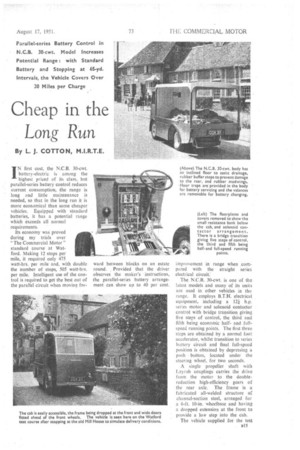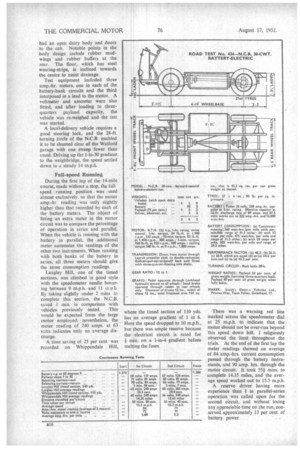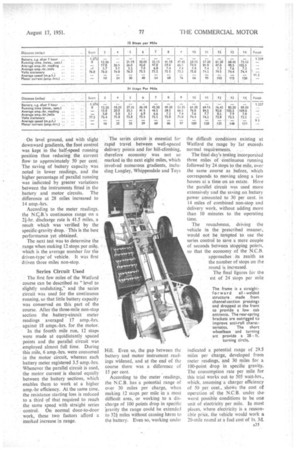Cheap in the
Page 49

Page 50

Page 53

If you've noticed an error in this article please click here to report it so we can fix it.
Long Run By L. J. COTTON, M.I.R.T.E.
IN first cost, the N.C.B. 30-cwt, battery-electric is among the highest priced of its class, but parallel-series battery control reduces current consumption, the range is long and little maintenance is needed, so that in the long run it is more economical than some cheaper vehicles. Equipped with standard batteries, it has a potential range which exceeds all normal requirements.
Its economy was proved during my trials over "The Commercial Motor" standard course at Watford. Making 12 stops per mile, it required only 475 watt-hrs, per mile and, with double the number of stops, 505 watt-hrs. per mile. Intelligent use of the control is required to get the best out of the parallel circuit when moving for ward between blocks on an estate round. Provided that the driver observes the maker's instructions, the parallel-series battery arrangement can show up to 40 per cent. improvement in range when .compared with the straight series electrical circuit.'
The N.C.B. 30-cwt. is one of the latest models and many of its units are used in other vehicles in the
range, It employs B.T.H. electrical equipment, including a 121 h.p.
series motor and solenoid contactor control with bridge transition giving five steps of control, the third and fifth being economic halfand fullspeed running points. The first three steps are obtained by a normal foot accelerator, whilst transition to series battery circuit and final full-speed position is obtained by depressing a push button, located under the steering wheel, for two seconds.
A single propeller shaft with Layrub couplings carries the drive from the motor to the doublereduction high-efficiency gears of the rear axle. The frame is a fabricated all-weldedstructure of channel-section steel, arranged for a 6-ft. 10-in, wheelbase and having a dropped extension at the front to provide a low step into the cab.
The vehicle supplied for the test
had an open dairy body and doors to the cab. Notable points in the body design include robber mudwings and rubber buffers at the rear. The floor, which has steel wearing-strips, is inclined towards the centre to assist drainage.
Test equipment included three amp.-hr. meters, one in each of the battery-bank circuits and the third interposed in a lead to the motor. A voltmeter and ammeter were also fitted, and after loading to threequarters payload capacity, the vehicle was re-weighed and the test was started.
A local-delivery vehicle requires a good steering lock, and the 28-ft. turning circle of the N.C.B enabled it to be shunted clear of the Watford garage with one sweep fewer than usual. Driving up the 1-in-30 gradient to the weighbridge, the speed settled down to a. steady 14 m.p.h.
Full-speed Running During the first lap of the 14-mile course, made without a stop, the full speed running position was used almost exclusively. so that the motor amp.-hr reading was only slightly higher than that recorded by each of the battery meteis. The object of fitting an extra meter in the motor circuit was to compare the percentage of operation in series and parallel. When the vehicle is running with the battery in parallel. the additional meter summates the readings of the other two instruments. When running with both banks of the battery in series, all three meters should give the same consumption readings.
Langley Hill, one of the timed sections, was climbed in good style with the speedometer needle hovering between 9 m.p.h. and 11 in.p h By taking slightly under 2 mins to complete this section, the N.C.B. saved I min. in comparison with vehicles previously tested. This would be expected from the large motor employed: nevertheless, the meter reading of 240 amps. at 63 volts indicates only an average discharge.
A time saving of 25 per cent was recorded on Whippendale Hill,
where the timed section of 110 yds. has an average gradient of 1 in 6. Here the speed dropped to 10 m.p.h., but there was ample reserve because the electrical circuit is rated for
min. on a 1-in-4 gradient before melting the fuses.
There was a warning red line marked across the speedometer dial at 25 m.p.h. to indicate that the motor should not be over-run beyond this speed down hill. I religiously observed the limit throughout the trials. At the end of the first lap the meter readings showed an average of 84 amp.-hrs. current consumption passed through the battery instruments, and 90 amp. hrs. through the motor circuit. It took 55i mins. to complete 14.35 miles, and the average speed worked out to 15.5 m.p.h.
A reserve driver having more experience than I in parallel-series operation was called upon for the second circuit, and without losing any appreciable time on the run, conserved approximately 13 per cent. of battery power On level ground, and with slight downward gradients, the foot control was kept in the half-speed running position thus reducing the current flow to approximately 50 per cent. The saving of battery capacity was noted in lower readings, and the higher percentage of parallel running was indicated by greater variations between the instruments fitted in the battery and motor circuits. The .difference at 28 miles increased to 14 amp.-hrs.
According to the meter readings, the N.c.B.'s continuous range on a 2k-hr. discharge rate is 41.5 miles, a result which was verified by the specific.gravity drop. This is the best performance yet obtained.
The next test Was to determine the range when making 12-stops per mile, which is the average number for tile driven-type of vehicle. It was first driven three miles non-stop, Series Circuit Used The first few miles of the Watford course can be described as "level to slightly undulating," and the series circuit was used for the continuous running, so that little battery capacity was conserved on this part of the course. After the three-mile non-stop section the battery-circuit meter readings averaged 17 amp.-hrs. against 18 amps.-hrs. for the motor.
In the fourth mile run, 12 stops were made at equidistantly spaced points and the parallel circuit was employed almost full time. During this mile, 6 amp.-hrs. were consumed in the motor circuit, whereas each battery meter registered 3.5 amp.-hrs. Whenever the parallel circuit is used, the motor current is shared eqUally between the battery sections, which enables them to work at a higher amp.-hr efficiency. At the same time, the resistance starting loss is reduced to a third of that required to reach the same speed with straight series control. On normal door-to-door work, these two factors afford a marked increase in range. The series circuit is essential for rapid travel between well-spaced delivery points and for hill-climbing, therefore economy was not so marked in the next eight miles, which involved numerous gradients, including Langley, Whippendale and Toys Hill. Even so, the gap between the battery and motor instrument readings widened, and at the end of the course there was a difference of 15 per cent.
According to the meter readings, the N.C.B. has a potential range of over 30 miles per charge, when making 12 stops per mile in a most difficult area, or working to a discharge of 100 points drop in specific 'gravity the range could be extendeJ to 321 miles without causing harm to the battery. Even so, working under
the difficult conditions existing at Watford the range by far . exceeds normal requirements.
The final day's testing incorporated three miles of continuous running followed by 24 stops to the mile, over the same course as before, which corresponds to moving along a few houses at a time on an estate. Here the parallel circuit was used more extensively and the saving on battery power amounted to 30 per cent. in 14 miles of combined non-stop and delivery work, without adding more than 10 minutes to the operating time.
The roundsman, driving the vehicle in the prescribed manner, would not be tempted to use the series control to save a mere couple of seconds between stopping points, so that the economy of the N.C.B. approaches .its zenith as the number of stops on the round is increased.
The final figures for the est of 24 stops per mile indicated a potential range of 29.5 miles per charge, developed from meter readings, and 30 miles for a 100-point drop in specific gravity. The consumption rate per mile for this trial works out to 505 watt-hrs., which, assuming a charger efficiency of 50 per, cent., shows the cost of operation of the N.C.B. under the worst possible conditions to be one unit of electricity per mile. In most places, where electricity is a reasonable price, the vehicle would work a 20-mile round'at a fuel cost of Is. 3d.




















































































